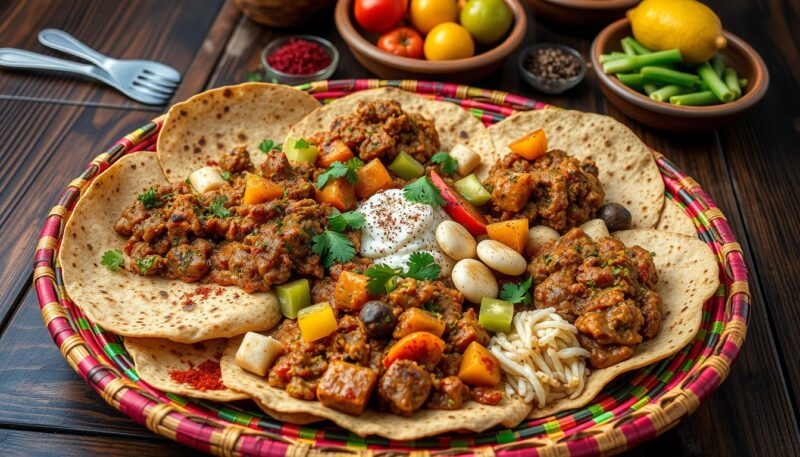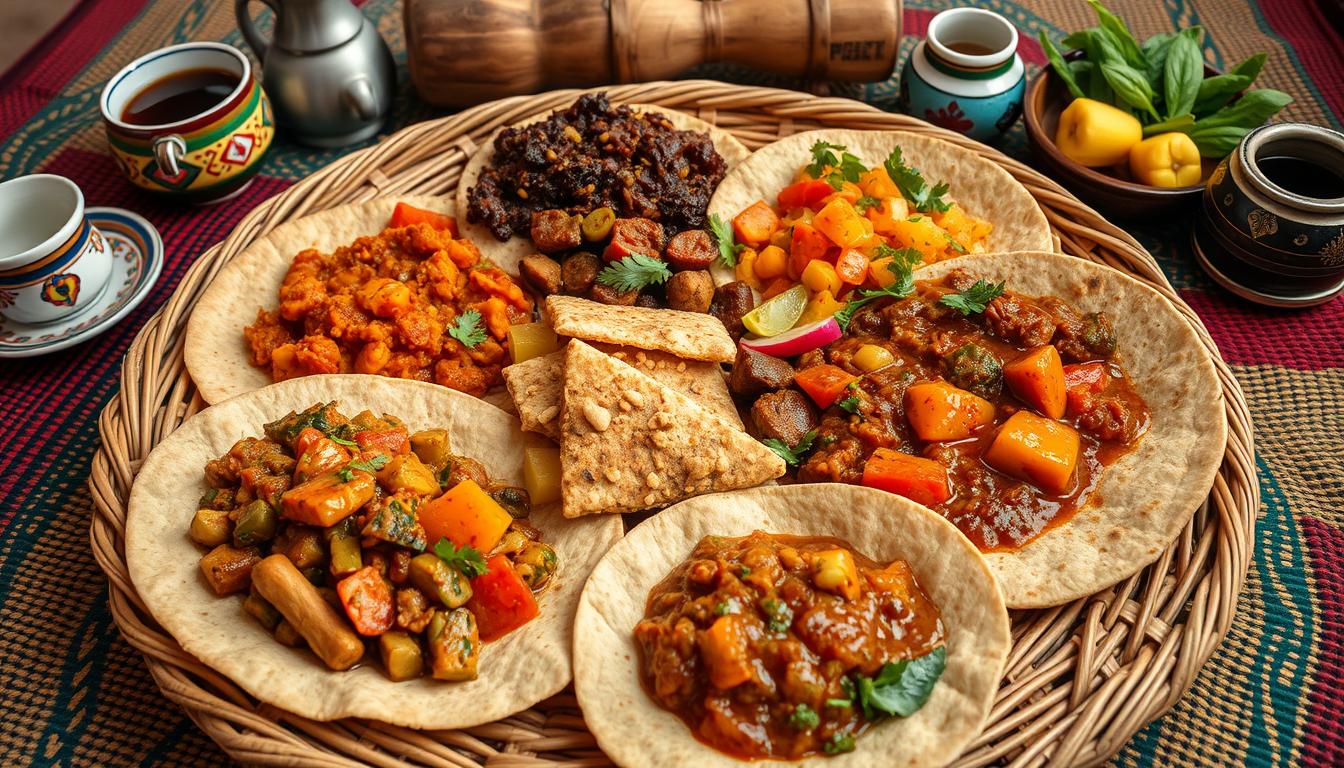If you find yourself craving a vibrant culinary experience, Ethiopian cuisine is a treasure trove waiting to be explored. Deeply rooted in history, this flavorful food culture reflects the unique culinary artistry of the region, characterized by meticulous spice blends and communal dining. Emphasizing not just taste, but also the tradition of eating together, Ethiopian meals are more than just food; they embody a cultural experience you won’t want to miss. This guide will introduce you to seven must-try Ethiopian dishes that highlight the essence of this delightful cuisine, perfect for food lovers embarking on an unforgettable journey.
During a recent visit to King Solomon and Queen of Sheba Ethiopian Restaurant in Toronto, I had the opportunity to dive into some authentic Ethiopian flavors. Nestled in the heart of Little Ethiopia, the restaurant is surrounded by a concentration of Ethiopian eateries that invite culinary enthusiasts to explore. My friends and I shared a fantastic meal, featuring impressive dishes that illustrated the joy of sharing and community in Ethiopian food, which remains a hallmark of the dining experience.
Throughout this article, you will learn more about not just the dishes themselves but their cultural significance within Ethiopia. Whether you are a seasoned food explorer or just getting started, this Ethiopian food guide will equip you with the knowledge necessary to navigate the delightful landscape of top Ethiopian foods. So, let’s dig in and discover the best Ethiopian dishes waiting for your palate!
Introduction to Ethiopian Cuisine
Ethiopian cuisine offers a delightful exploration of flavors, aromas, and traditions that make dining a cultural experience. At the heart of Ethiopian food culture lies injera, a 50-centimeter sourdough flatbread made from teff flour, serving as both plate and utensil for various traditional Ethiopian meals. The cuisine is famed for its unique spices and communal dining style, often featuring a vibrant array of Ethiopian cuisine specialties.
What Makes Ethiopian Cuisine Unique?
The uniqueness of Ethiopian cuisine stems from its complex flavor profiles, heavily influenced by spices such as berbere, a mixture that includes chili, fenugreek, and garlic. This spice mix enhances diverse dishes, known as wots, that feature meats, legumes, and vegetables. Additionally, the fermentation process of injera contributes to its distinctive taste, making it a staple component of meals in Ethiopia. Incorporating fasting-friendly vegan dishes due to cultural observances allows for a wide variety of options that cater to both dietary needs and preferences, enriching the Ethiopian food experience.
The Emphasis on Sharing and Tradition
Ethiopian food culture places a strong emphasis on communal dining, where traditional meals are often served on a large platter called a gebeta. The practice of eating in Ethiopia encourages sharing and connection among diners. This is beautifully illustrated in the tradition of gursha, where one person feeds another, reinforcing bonds of friendship and family during meals. Guests often partake in the Ethiopian coffee ceremony, a cherished custom following meals, enhancing the social atmosphere and showcasing the warmth of Ethiopian hospitality.

| Characteristic | Description |
|---|---|
| Injera | A staple sourdough flatbread that serves as a base for meals. |
| Wots | Stews that incorporate meats or vegetarian options, featuring rich flavors. |
| Spices | Berbere and mitmita enhance dishes with distinct heat and depth. |
| Communal Dining | Meals are shared from a common plate, promoting connection. |
| Coffee Ceremony | An integral part of Ethiopian culture, highlighting social interactions. |
Must-Try Ethiopian Dishes
Ethiopian cuisine is marked by a unique approach to dining, where communal sharing reigns supreme. A large circular tray filled with injera and various flavorful options invites you to explore the best Ethiopian dishes. Here are some top Ethiopian recipes that promise a delightful food experience.
Injera: The Heart of Every Meal
Injera is essential in traditional Ethiopian meals. This gluten-free flatbread made from teff flour has a spongy texture and a unique sour flavor due to fermentation. Serving as both a base and an edible utensil, it absorbs the rich flavors of the accompanying stews. Without injera, an Ethiopian food experience would feel incomplete.
Shiro Wat: A Popular Vegetarian Option
Shiro wat offers a creamy, satisfying choice for those exploring vegetarian options. Made from ground chickpeas or broad bean flour blended with onions and garlic, this dish stands out among Ethiopian cuisine specialties. Its simplicity makes it a beloved pick during fasting times, showcasing the adaptability of Ethiopian food culture.
Doro Wat: The Beloved Chicken Stew
Doro wat, often considered the national dish, features chicken simmered in a rich sauce of berbere spices and onions. This aromatic dish, usually decorated with hard-boiled eggs, is a staple during special occasions and holidays. A must-try Ethiopian food, each bite represents a tradition that welcomes you into Ethiopian cuisine culture.
Misir Wat: Red Lentil Delight
Misir wat, simmered red lentils infused with berbere spices, highlights the depth of flavor present in Ethiopian dishes to try. Commonly served with injera, this vegetarian delight showcases not only the culinary artistry of Ethiopia but also its reliance on wholesome ingredients.
Key Wat: A Flavorful Beef Stew
Key wat is a hearty beef stew that embodies the richness of Ethiopian flavors. Prepared with tender beef and seasoned with a spice blend, it offers a complex taste experience perfect for pairing with injera. This dish is a great introduction to popular dishes in Ethiopia, inviting you to savor its robust sauce.
Salata: Refreshing Ethiopian Salad
Salata, a vibrant tomato salad seasoned with olive oil and lemon juice, acts as a refreshing palate cleanser amid the spices. This simple dish balances the flavors on the dining table, making it a common side in traditional Ethiopian meals. Its freshness highlights the variety and thoughtfulness in Ethiopian cuisine.
Kitfo: A Delicacy of Minced Meat
Kitfo, made from raw minced beef, offers a bold choice for adventurous eaters. Often compared to French steak tartare, you can customize its doneness to suit your taste. Typically served with gomen and aib, this dish delves deep into the creativity of Ethiopian street food, providing a unique indulgence within your culinary journey.

| Dish | Main Ingredients | Flavor Profile | Commonly Served With |
|---|---|---|---|
| Injera | Teff flour | Sour, spongy | Stews, salads |
| Shiro Wat | Chickpeas, onions, garlic | Rich, creamy | Injera |
| Doro Wat | Chicken, berbere spices, eggs | Aromatic, spicy | Injera |
| Misir Wat | Red lentils, berbere spices | Hearty, flavorful | Injera |
| Key Wat | Beef, berbere spices | Robust, savory | Injera |
| Salata | Tomatoes, onions, olive oil | Fresh, tangy | Traditional meals |
| Kitfo | Raw minced beef, spices | Rich, bold | Gomen, aib |
Conclusion
Ethiopian cuisine is a delightful exploration into a world filled with rich flavors and vibrant traditions. Each dish, from the beloved injera to the aromatic doro wat, reflects the unique Ethiopia food culture that emphasizes communal sharing and celebration. As you indulge in these must-try Ethiopian food items, you’ll find a culinary experience that is both traditional and diverse, inviting you to savor every bite.
The dishes themselves tell a story of Ethiopia’s rich heritage, showcasing not only local ingredients but also a commitment to health, such as using teff flour—packed with essential nutrients. The meticulous blending of spices like berbere provides not just flavor but health benefits too, making each meal a wholesome experience.
Whether you’re enjoying a special occasion with doro wat or a cozy night at home with a dish of shiro wat, Ethiopian food culture provides a unique opportunity to gather around the table. Embrace the flavors, immerse yourself in the traditions, and remember that every shared meal enhances the joy of dining together, creating memories that last long after the table is cleared.

